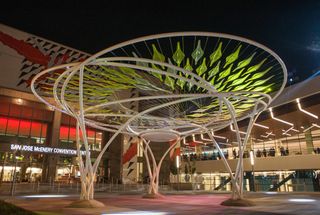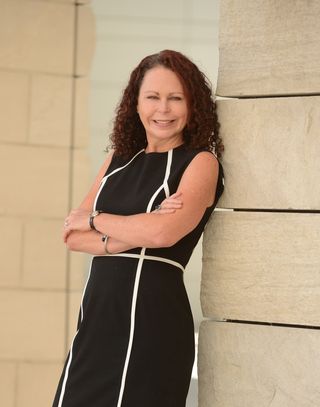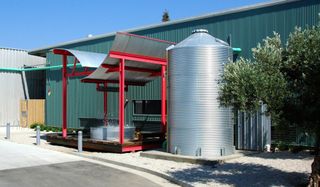
Tech Art at the Heart of Silicon Valley

Paulette Beete, NEA senior writer-editor, contributed this article as part of partnership between NEA and Live Science's Expert Voices: Op-Ed & Insights.
San Jose, California, can boast of having produced more patents than any other U.S. city, according to U.S. census figures — not surprising given its stature as the unofficial capital of Silicon Valley. What may be surprising, however, is that the city also holds a soft spot for art. In fact, it even has the distinction of housing the largest collection of Ludwig van Beethoven artifacts outside of Europe, thanks to the Ira F. Brilliant Center for Beethoven Studies. Given that creativity is at the heart of both the arts and technology, it makes sense that the arts would flourish amidst the landscape of labs and tech centers.
With a diverse population of more than one million, many of whom are foreign-born technology workers, San Jose is home to the headquarters of tech giants such as Adobe and eBay. Alongside several theaters, a performing arts center and a diverse array of museums, the city is also the base for organizations like ZERO1, whose work takes place in the fertile space where tech and art overlap.
At a municipal level, the city supports the arts ecosystem via the San Jose Office of Cultural Affairs (OCA), which hosts a robust public arts collection that currently comprises 250 artworks at 130 sites throughout the city. I recently spoke with San Jose Office of Cultural Affairs Director Kerry Adams Hapner to learn more about the unique connection between the arts and technology in the heart of Silicon Valley, and you can see a gallery of some of the most dramatic artworks from the program here.

On arts and technology partnerships in San Jose:
Kerry Adams Hapner: Within Silicon Valley, we have an interesting place where we have a very high percentage of the population that works within the tech sector. They come from all over the world, so having multicultural art is very important. In San Jose we have a wide variety of different types of disciplines and genres that are represented by multicultural arts organizations. What is also part of our area's authentic cultural life is that a lot of people are actively doing arts and cultural activities through forms of creative self expression. They're singing in the church choir, they're tinkering in the garage, they're doing maker type stuff on the weekends.
For example, one of the most popular parts of the San Jose Jazz Festival is actually these late-night performances by Silicon Valley leaders. The festival places performers in different types of spaces and venues across downtown San Jose and they showcase the talents of our local high-tech workers. Another example is that the Tech Museum of Innovation is moving away from blockbuster exhibits and now their focus is more on makers and making this cultural facility a space for people to come together, build community, and build things and exchange ideas.
Sign up for the Live Science daily newsletter now
Get the world’s most fascinating discoveries delivered straight to your inbox.
I also think that there's a big boom for the art and cultural sector, first and foremost, just in the way that people are interacting with the arts online with their handheld devices. We have a very prolific use of technology for accessing the arts in San Jose.
In regards to philanthropy, we have had a lot of very generous philanthropists that are coming from the tech sector that are supporting the arts. Additionally we have a lot of corporate citizens that are supporting the arts whether it's Adobe or Applied Materials, for example. And then we have several major tech corporations whose founders have developed major foundations such as the Packard Foundation or the Hewlett Foundation.
Partnerships range from people who are working in tech sectors that serve on boards or are audiences to corporations that are providing in-kind services or equipment like the computer monitors at the Museum of Art for its current show that features new media work.
Investing in the arts invests in the creative process that can tell the story of technology, help people to connect with each other across a technological platform, or even help inform a creative intervention – which is crucial to innovation and adaptive change. In San Jose, we have great corporate citizens. Yet, there does exist a gap – many companies think globally but not necessarily locally. Investment in the arts is an investment in community, our quality of life and education – which attracts and retains an educated and talented workforce. Businesses are competing for talent.
On fostering arts participation in the community:
K.A.H.: I think increasingly we know that audiences are looking for an interactive participatory experience, a way in which they can create their own experience. The City of San Jose is working on a national project that is called Building Public Will for the Arts and Culture, which is about how you make the arts an expected part of the everyday lives of the people that you're serving. We're trying to understand what are the closely held existing values of people in San Jose. They care about creative self expression and experiences that offer them the ability to express themselves creatively. They care about connecting with their family and their friends, and they care about their health and wellbeing.
Rather than making people art consumers or art advocates, we're trying to meet people where they already are. We want to engage in a conversation with them about their closely held values and then link the arts to those closely held values. That's really the framework in which we're looking to reposition the arts and culture and have a conversation with a broader amount of people about relating the arts to those value systems that people care about. Through that conversation, you might call it a gateway conversation, then you're able to bring people to the arts and culture by offering them programs that are participatory that give them the ability to connect with themselves and their family and their friends and that are opportunities for creative self expression.
On public art and technology
K.A.H.: San Jose's Public Art Program has done a lot of work looking at the intersection between art and technology and art and science . In particular we have a series of works that are interactive and participatory in nature. For example, we have illuminated art works in our downtown that you can call by cell phone and you can change the displays.
Another example is a great illuminated artwork at the top of the Adobe Headquarters building in our downtown called San Jose Semaphore, by the artist Ben Rubin. It's essentially a series of four oscillating LED "wheels." At first you just think, oh that's interesting because it's always dynamic. But what is happening actually is that the discs represent a code and [the artist] is looking for local programmers to figure out what his code is. This is actually the second code that he's put up. The first one was, I think, cracked within the first week of it going up.

A couple of years ago the City of San Jose built a new terminal as part of the San Jose International Airport. As part of that major capital construction project, we were able to integrate a whole new media arts collection. We really wanted to showcase and highlight the innovation that happens within San Jose and within Silicon Valley, and we recognized that our airport was, in fact, a gateway to Silicon Valley. So we wanted to have art that would reflect the spirit of aspiration and the spirit of innovation that happens there.
Within the airport, as you're walking through it, you'll see a series of art installations around the theme of art and technology. They include a robot, called Space Observer, and on the face of the robot is a monitor on which you can see yourself. There's also another work called eCloud, and it's a sculptural installation, hung from the ceiling, that has panes of glass about two inches by two inches and their opacity changes [according to] international weather patterns that are coming from NOAA [National Oceanic and Atmospheric Administration]. There's also a monitor so you can see where the weather system [influencing the sculpture] is coming from.
In addition to our Art and Technology program, our Public Art Program is doing a lot of work right now with our Environmental Services Department. Through a series of artist interventions we're able to help promote environmental stewardship and better understanding about our own role as individuals in influencing the environment.

We have a couple of projects that we're working on right now, one of which relates to the way that people are using our sewer treatment system. In different communities, sometimes there are issues of people putting different types of things down the drain — like fats, oils and grease — that create sanitary system overflows. So we have an artist team that's working on how do you change people's behavior about not putting the deep-fried oil down the drain, that maybe you dispose of that in a different way. [They're looking at] what are the socioeconomic ethnic barriers to understanding [better disposal practices]. [Behind The Scenes: What Lies Beneath? Understanding Art Using Science ]
We're also doing some work with that department on helping people better understand the relationship between our creeks and our watersheds and the water that goes into the San Francisco Bay. I think that's another area of tremendous possibility going forward into the future — using the arts and the vocabulary of the arts to help promote environmental stewardship.

San Jose's Public Art Program is funded through a municipal ordinance in which the City of San Jose sets aside one percent of capital improvement project costs for public art. When capital projects are moving forward, we identify which ones might be a good opportunity to integrate public art into. Then we build out a scope and a budget, and based on this scope, the nature of the project, and the budget size, we identify the type of artist that we're looking for, and any special skills or areas of expertise that we're looking for. Do those skills and expertise exist within our local artist community? Do we need to do a broader call? Do we want to go statewide, regional, national, or international? Then we do a call for artists to submit their qualifications to us after which we convene a panel that comprises key stakeholders with [various] areas of expertise that comes together and reviews the artists' qualifications. We typically interview a couple of finalists and then we make a recommendation for which one we want to move forward with. Then that selection is approved by our Public Art Committee.
On involving the tech community in public art projects
K.A.H.: If [a project] requires a certain type of expertise within an area of technology, then absolutely that artist is working within the tech sector to understand what are the resources available to him or her, and what's the best use of the technology or what technology is available to him or her. For example, we have a project that's moving forward right now with artist Dan Corson. It's an illuminated artwork that's going to be at an underpass. Dan is making sure that this work is interactive so that when you move through the space, you're actually going to be able to help change what you're looking at. In order to develop this, he worked with a Google lab called Ninantics Lab. He absolutely wanted to take advantage of the resources that were available to him within the tech sector and we've been collaborating with one of our local high tech companies.

On why collaboration between the arts and technology matter
K.A.H.: Art and technology are both tools. Art is a tool for communication — communicating ideas, beliefs, experiences, stories and human expression. Art communicates what it means to be human today. Artifacts are tools that humans have used throughout civilization to communicate and progress. Technology serves a similar function. They are extensions of humans. Through an interdisciplinary approach, art and technology amplify the intent of the work — whether through the visual impact, the means to develop the artwork, or just though the delivery of the message. Collaborations across sectors enable us to learn through each other in an interdisciplinary environment — leveraging expertise and skills. Creative interdisciplinary collaborations and partnerships will drive the future.
Caption information by Kerry Adams-Hapner. Follow all of the Expert Voices issues and debates — and become part of the discussion — on Facebook, Twitter and Google+. The views expressed are those of the author and do not necessarily reflect the views of the publisher. This version of the article was originally published on Live Science.
Most Popular


